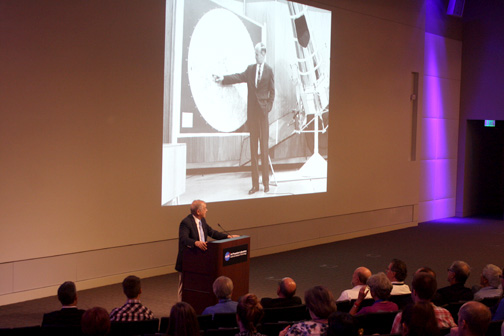
By Mary O’KEEFE
The Jet Propulsion Laboratory did something it doesn’t do that often – it dedicated a building on the lab to someone.
Dr. William Pickering was posthumously honored by having the 321 building on the lab at JPL dedicated in his name. The building was completed in 2009 and was the first LEED Gold facility for NASA. LEED, or Leadership in Energy and Environmental Design, is a green building certification program that recognizes the best-in-class building strategies and practices.
“This is a very special occasion for [the] JPL family and JPL history,” said Larry James, deputy director JPL. “It is a very special day for JPL. Most of you probably know when you roam around the lab and you are told to go to a building for a meeting it is normally a building number and you have to look on the map and figure out where it is. But the fact that we are naming a facility for an individual is a very special thing. As you know, there are not many buildings or facilities named for an individual here at JPL and, frankly, that is true across all federal facilities.
“It is a very special event to name a facility for a person.”
Dr. Pickering was the director of JPL from 1954 to 1976. He was known, according to present director Dr. Charles Elachi, as “Mr. JPL.”
James told the audience at the newly christened Pickering Auditorium that the submission process for the dedication went quickly and smoothly through NASA bureaucracy.

“There was never any question. There was never any push back, it was, ‘Yes, this is exactly the right thing to do to honor Bill Pickering,’” James said.
Pickering led the successful effort to place the first U.S. satellite, Explorer 1, into Earth’s orbit. He began with JPL years earlier in 1944 when JPL was working on rockets for the military, but it was the transition to space exploration that changed everything. It was the leadership of Pickering that laid the foundation of what JPL has become today.
“The Jet Propulsion Lab became part of the fabric of the American culture,” said David Crouch from the NASA management office.
He added that JPL is known around the world and people are curious as to what is being done at the lab.
“[There is] a fascination with the work that is being performed here and that is really a testament to Dr. Pickering’s work when he was director, and the places where he has taken the lab and where we are today,” Crouch said.
When Elachi began at the lab, Pickering was the director. He quoted President Theodore Roosevelt – “Far better is it to dare mighty things, to win glorious triumphs, even though checkered by failure … than to rank with those poor spirits who neither suffer much, because they live in a gray twilight that knows not victory nor defeat.”
“That describes Dr. Pickering very well,” Elachi said.
He told the audience that while Pickering was director the lab saw ups and downs but it kept going.
“Right after NASA was formed they asked Pickering to come up with a plan for exploring the solar system. At that time we barely knew how to launch things and here you have Pickering and the team laying out how to explore the solar system,” he said.
One of the first things JPL was tasked to do was to crash a rocket into the Moon as part of President John F. Kennedy’s challenge to land a man on the Moon and to safely return to Earth. Part of the preparation was to crash an unmanned craft, the Ranger mission, on the surface.
“We failed six times … once we missed the Moon,” he said. “There was tremendous pressure on the lab, it was the cold war.”
Pickering and his team did not give up and were successful.
“The lab didn’t quit, they focused on the challenge and here we are today,” Elachi said.
Pickering was born in New Zealand and although he was also an American citizen he never gave up his citizenship of his birth country, and always supported his hometown.
The New Zealand Consul-General Hon. Leon Grice also spoke at the dedication. He shared the story of how Pickering was inspired by a teacher who had built a telescope for the kids to view the night sky.
But beyond a scientist and leader Pickering was a father, and his daughter Beth Pickering Mezitt shared a personal portrait of the man.
“When I was a child in Altadena I knew my dad taught at Caltech and that he spent a lot of his time at JPL doing something with rockets,” Pickering Mezitt said. “I didn’t know much more than that because the work was highly classified … Then Explorer 1 went into orbit.”
That was when the fun began. Pickering shared his excitement with what was happening on the lab.
“Suddenly the stories flowed, the plans were bandied about and the jokes flew,” she said. “My dad’s excitement was huge.”
After he retired in 1976, he continued to follow the progress of JPL and was invited by the staff to important events, Pickering Mezitt said.
“You are honoring him in a most wonderful way… this is where his heart is and you have honored that,” she said.
